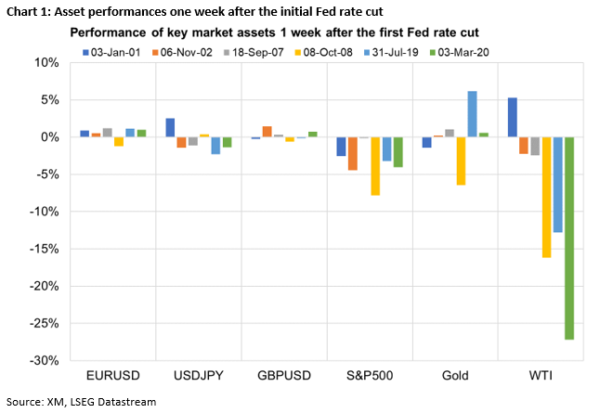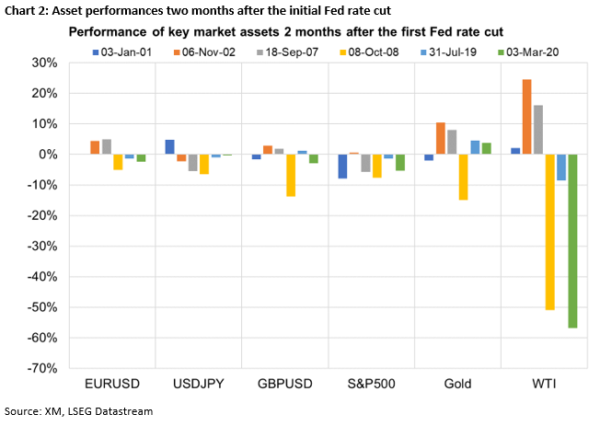- US labour market data to determine the size of the first Fed rate cut
- History points to an increased possibility of a 50bps move
- Analysis reveals sizeable equities’ weakness after the initial cut
Following Fed Chairman Powell’s appearance at the Jackson Hole Symposium and this indirect announcement of the much-discussed Fed rate cut, the market is counting down to the September 18 meeting. This week’s labour market data could play a role in the size of this rate move with a negative set of prints potentially keeping the door open to a 50bps decrease.
This rate cut will be the first interest rate reduction since the 150bps of easing announced during March 2020 amidst the COVID pandemic outbreak. One must go back to 2019 for the first “normal” monetary policy easing with three consecutive 25bps cuts announced back then. Powell called these rate cuts “mid-cycle adjustment” as inflation was below the 2% level and the trade war between the US and China was in full swing.
Six initial rate cuts since 2000
Scrolling through the Fed’s actions since 2000, six easing cycles can be identified. Table 1 below shows the details of the initial interest rate cuts with both the 2002 and 2008 reductions featuring in the list. Both moves came after extensive Fed pauses and are hence each treated as the start of a new easing cycle.
The market is currently pricing in a 39% possibility of a 50bps rate move in two weeks’ time. This looks low considering that on five out of the six occasions examined, the Fed commenced its rate cut cycle with a 50bps move. However, such a move might be more difficult this time around since the US data on the whole are satisfactory, and the US presidential election is just around the corner.
Additionally, the market is currently expecting around 103bps of easing until year-end. As there are just three meetings left in 2024, the Fed is expected to announce rate cuts at every gathering, including the November 7 one. Historically, the Fed announced back-to-back cuts on four of the six periods examined.
How did the market perform one week after the initial Fed rate cut?
Chart 1 below presents the performance of key market assets one week after the initial Fed rate cut. Digging through the data, some interesting trends can be identified. Specifically, the S&P 500 stock index dropped by an average of 3.7% in the six periods examined, reflecting the market’s concerns about the overall economic outlook.
Interestingly, the US dollar tends to suffer in the aftermath of the initial Fed rate cut with euro/dollar rallying in five out of the six periods examined. Additionally, with the exception of 2001, WTI oil futures usually fall by 2.3%-27.2%, potentially reflecting the market’s concerns about a significant economic slowdown, and even recession.
Asset performances two months after the first rate cut
The picture becomes less clear when analyzing the market’s performance two months after the first Fed rate cut. However, this timeframe is rather important as it encompasses the November 5 US presidential election and the subsequent Fed meeting (November 7).
As seen in Chart 2 below, WTI oil futures suffered in 2008, 2019 and 2020, while the US dollar had a more mixed performance in the two months after the initial rate cut. On the flip side, based on the analysis’ findings, the 10-year US treasury yield tends to fall by an average of 38bps in the examined timeframe.
Additionally, the S&P 500 index was under pressure in five of the six periods examined as market participants were quite anxious about the state of the US economy. Interestingly, this equities’ weakness was one of the key findings in an earlier special report analyzing the performance of key assets two months ahead of the US presidential election.















